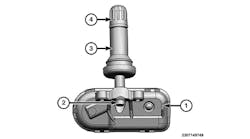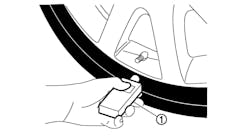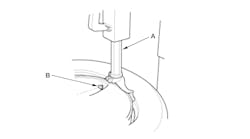When Congress first directed the National Highway Traffic Safety Administration (NHTSA) to mandate a system that would monitor the tires on new vehicles and warn the driver of an under-inflated tire(s), it was a direct response to numerous tire-related accidents that occurred primarily in the South as the result of the excessive heat.
Over a decade later, millions of cars, SUVs and light trucks currently include a tire pressure monitoring system (TPMS) that notifies the operator when one or more of the tires are 25% below the inflation pressure listed on the vehicle’s tire placard. Without a doubt, the original purpose of TPMS was to improve safety on the highway.
In April of 2012, NHTSA published the results of a study from the National Center for Statistics and Analysis (which is a division of NHTSA), “Tire-Related Factors in the Pre-Crash Phase.” After analyzing a sample of 5,470 crashes (out of 2,188,970 crashes at the national level) from 2005-2007, the study came to the following conclusion on the relationship between accidents and under-inflated tires:
“Of the tires that were under-inflated by more than 25% of the recommended pressure, approximately 10% were in vehicles that experienced tire problems in the pre-crash phase. In contrast, among the correctly inflated tires, a much smaller percentage (3.4%) belongs to vehicles that experienced tire problems. Thus, under-inflation is not the only cause of tire problems; however, when tires are under-inflated by 25% or more, tires are three times as likely to be cited as critical events in the pre-crash phase.”
Since the crash data was collected during a time frame when TPMS was not required by NHTSA, only 2% of the estimated 3,889,770 vehicles were even equipped with a tire pressure monitoring system. After some incredibly complex mathematics to someone like me, the study calculated a Z-value that gave an indication of whether under-inflated tires were a factor in accidents involving vehicles with TPMS. Statistically, the number of tires that were under-inflated by more than 25% were “significantly less than expected,” and when TPMS was used, “correctly inflated tires were significantly more likely than chance.” The report went on to say that of the tires over-inflated by more than 10%, “significantly less than expected tires were over-inflated... when this device is used.” I thought that was a ringing endorsement for TPMS, but was disappointed that it consisted of a chart with a few brief paragraphs and didn’t make the executive summary.
[PAGEBREAK]
However, NHTSA went a step further in November 2012 and published another technical report, “Evaluation of the Effectiveness of TPMS in Proper Tire Pressure Maintenance.” This Report found that 23.1% of the 2004-2007 models without TPMS had at least one severely under-inflated tire, but only 11.8% of the same model year vehicles with TPMS had a severely under-inflated tire.
There was no information on the number of tire-related accidents for TPMS and non-TPMS in this particular report. However, for a government agency looking to justify Federal Motor Vehicle Safety Standard (FMVSS) No. 138, this improvement in tire pressure maintenance was an obvious benefit that must be recognized. After all, under-inflated tires have always posed a significant risk to motorists as evidenced by the 2003 NHTSA report that estimated 414 fatalities, 10,275 non-fatal injuries, and 78,392 crashes occurred annually as the result of flat tires or blowouts. Therefore, any system that can potentially reduce the number of vehicles with overloaded tires would be a positive step in the right direction for motorist safety, so FMVSS No. 138 is working.
TPMS and fuel savings
But the government didn’t stop there.
According to the second NHTSA report, the adjusted fuel economy for a hypothetical new vehicle with TPMS was 27.04 mpg for passenger cars and 19.6 mpg for light trucks. On the other hand, the adjusted fuel economy for a hypothetical new vehicle without TPMS was 26.98 mpg for passenger cars and 19.52 mpg for light trucks.
After some more complex math, the report stated that over the first eight years of life with TPMS, the average passenger car is expected to save 9.32 gallons of fuel and the average light truck is expected to save 27.89 gallons of fuel.
In the first of many assumptions, the report also stated that:
“The dollar value of these estimated lifetime fuel savings depends on fuel prices, but it is likely to account for a substantial portion of the consumer’s cost of a new TPMS, which was estimated in 2007 dollars to range from $100 to $202.30 for a passenger car and from $135.62 to $234.55 for an LTV. These estimates do not reflect any maintenance or repair costs, only the cost of a new system.”
I suppose when gas is $20 a gallon that might be true, but NHTSA wasn’t finished making some interesting leaps in logic. Using some even more incredibly sophisticated mathematical formulas, NHTSA also estimated that TPMS saved 142,915,684.6 gallons of fuel in 2011, which translates to $511,066,488 if the price of gas is assumed to be $3.576 a gallon. According to the government, if every vehicle in model years 2004-2011 had been equipped with TPMS, the United States would have saved 218,378,259.9 gallons of fuel in 2011 alone, or $780,920,657 using the same $3.576 price for a gallon of fuel.
To quote one of my favorite actors/comedians Chevy Chase as President Gerald Ford in a legendary old Saturday Night Live skit, “It was my understanding there would be no math.” Since I don’t know the difference between my sigma, my Z-value or the selection probability of my primary sampling unit, I felt the need to perform some real-world computations using formulas and data that everyone could understand. I decided to make a hypothetical estimation of my own on the potential savings using parts of the NHTSA report and data recently presented by the Automotive Aftermarket Industry Association (AAIA) at Autopromotec in Bologna, Italy.
According to AAIA research, the average car travels 10,649 miles in a year. If we use the NHTSA estimated fuel mileage for a vehicle with TPMS of 27.04 miles per gallon, every car with TPMS would use 393.82 gallons of gas in a year. Using the estimated fuel mileage of 26.98 for a vehicle without TPMS and the same number of miles, vehicles without tire pressure monitoring technology would use 394.70 gallons of gas, a difference of .88 gallons.
[PAGEBREAK]
AAIA research indicated that there are 248,800,000 vehicles in operation, so the .88-gallon savings per vehicle attributed to TPMS in 100% of the fleet would theoretically save the U.S. 218,944,000 gallons of fuel. When you multiply that savings by the $3.576 per gallon of gas figure used by NHTSA, TPMS could potentially save $782,943,744 when every vehicle in the U.S. is equipped with this technology, so the “pie in the sky” estimate from NHTSA appears to be fairly reasonable. That’s a number that would make Liberty (President Ford’s dog) roll over in his grave.
Outside of the opportunity to finally use some obscure Saturday Night Live references in a TPMS article, this exercise was intended to demonstrate that fuel economy is not a significant benefit of TPMS to the individual, but it could have a tremendous impact on the national stage. However, I’m fairly certain that the NHTSA officials responsible for these reports have never been behind the counter trying to explain that saving a whole gallon of gas each year justifies the expense of replacing dead sensors or buying new re-build kits.
And I’m equally positive that the estimated lifetime fuel savings is nowhere near “substantial” when compared to the cost of a new TPMS. So what’s the point?
Safety is still by far the most important benefit of TPMS, which means retailers must continue to focus on the role that proper tire inflation plays in the operation of the vehicle.
Sure, there are some additional benefits like reduced rolling resistance and a slight improvement in fuel economy. But the average consumer with math skills worse than mine can quickly see that the return on investment is virtually impossible to realize when it comes to dollars and cents using the data contained in the NHTSA report.
While TPMS can potentially improve tire service life and tread wear, those particular benefits still depend on motorists who regularly rotate their tires, not to mention check and adjust the inflation pressure before the light is illuminated on the instrument panel.
I remain a strong proponent of TPMS strictly because I’m convinced it will prevent accidents. With the growth in rim diameters and the reduction in aspect ratios, under-inflated tires will only become more difficult to identify with a visual inspection.
In the old days of 80-, 75- and 70-series tires, an attentive driver could look at the deflection on the lower sidewall and spot a tire that needed air most of the time.
Now that 50-, 45- and 40-series performance tires are common at the original equipment level, it will become even more unlikely that motorists will find a low tire just by looking at the sidewall.
Lazy consumers who spend hours looking for the remote control rather than get up to change the channel are not going to put a gauge to every tire until it’s too late. TPMS gives them the warning they need that prompts them to pay attention to their tires before the pressure gets to the point where a tire failure is imminent. The safety benefits of TPMS are immeasurable when lives hang in the balance, so that’s the message a motorist needs to hear.
Consumer education is the missing link
The Tire Industry Association (TIA) recently launched a quarterly consumer education program that revolves around the association’s new tagline, “Tire Safety Starts Here.”
In the first video, “Tire Safety Starts with Proper Tire Repair,” TIA shows motorists why tires should be removed from the rim before they are repaired. The second installment is titled “Tire Safety Starts with TPMS” and it is focused on the safety benefits related to this technology. There is a brief mention of the potential fuel savings and tread wear improvement, but the emphasis is on safety because that is the only concept that will convince most consumers to spend the money to maintain, repair and replace the TPMS on their vehicles.
[PAGEBREAK]
Consumer education continues to be the missing link for TPMS because the general public is unaware of what it does, why it’s there, and how it can save the lives of motorists. And by failing to create value in the minds of vehicle owners, the industry is now faced with millions of vehicles that will soon require new sensors and millions of drivers that will only see dollars and cents when faced with the decision to maintain the system.
Progressive retailers who have embraced TPMS technology and taken the time to explain the benefits to their customers over the past few years are more likely to reap the rewards of a new revenue stream, while those who have complained and resisted should not expect to see any positive changes in sales.
But TPMS should never be about money or profit. It started as a national movement to improve safety on the highway and somewhere along the line the message was distorted and the motorist ignored. The industry has gone to great lengths to convince retailers that there was a pot of gold at the end of the TPMS rainbow. Unfortunately, that leprechaun turned out to be a gremlin because the public still does not see the value and unless that changes, any safety benefits envisioned by Congress over a decade ago will be short-lived or minimal (see comments from dealers on this topic in the Your Turn column on page 106). Likewise, the estimated fuel savings recently proposed by NHTSA will be like money under the pillow after a visit from the tooth fairy.
Most consumers cannot be forced to replace a broken or inoperative TPMS, so they have to make a choice when confronted with one. NHTSA said as much in a letter of interpretation written to TIA a few years ago.
No one can possibly guess how many of the 2008-compliant model year vehicles will receive a replacement TPMS when it becomes necessary. And since there are so many variables and different options on the market, it is impossible to estimate for someone like myself.
But I’m going to stick my neck out anyway and make one prediction without any mathematical formulas to back it up. When a consumer is faced with the cost of replacing all of the sensors, at least half will decline if they live in a state without a periodic vehicle inspection program that includes TPMS.
In other words, if it isn’t illegal, the majority will drive around with the light on (like they already do with other dashboard warning lights).
If the industry is looking for another government report on the effectiveness of TPMS in preventing crashes, injuries or fatalities, here’s what NHTSA had to say in the summary of the November report, “Future analyses using real world crash data are necessary to evaluate the effect of TPMS on crash involvement.” This 2012 report used crash data that was at least five years old by the time it was published.
If the 2008 to 2011 statistics were analyzed for a more accurate picture using the same approach and timetable, we should expect that report around 2016. Of course by then, the TPMS on the 2008 models should start dying out, so we could look for another report in another five years on the long-term effect of TPMS on preventing accidents when motorists are not required to repair or replace the system.
Fortunately, it isn’t too late. TIA has taken a step in a positive direction with their consumer education program and the TPMS manufacturers that previously focused on retailers are increasing efforts to educate motorists. But the tire industry must do its part and constantly put those messages in front of their customers on their websites and in their showrooms in order to change public opinion.
While it’s difficult to estimate whether or not that effort will make a difference, it should still be easy to recognize that TPMS improves tire safety, and when consumers see the value in maintaining a particular vehicle safety system, profits will follow.
Unlike leprechauns, gremlins and the tooth fairy, the safety benefits of TPMS are very real, so retailers need to forget about complex government math and take advantage of the consumer education campaigns being put forth by TIA and the TPMS manufacturers, simply because it’s the right thing to do.
Or they can wait for Santa Claus to come down the chimney in about 10 years to magically make tire-related crashes disappear while filling their stockings with TPMS gold. ■
For a copy of “Tire-Related Factors in the Pre-Crash Phase,” click here.
www-nrd.nhtsa.dot.gov/Pubs/811617.pdf
For a copy of “Evaluation of the Effectiveness of TPMS in Proper Tire Pressure Maintenance,” click here.
www-nrd.nhtsa.dot.gov/Pubs/811681.pdf
Kevin Rohlwing is the Tire Industry Association’s senior vice president of training and a frequent MTD contributor.





